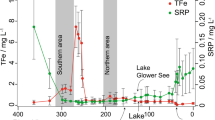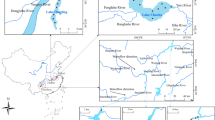Abstract
A small, highly eutrophic mining lake (Golpa IV) in eastern Germany with a continuous input of nutrients and metals was used to study the mechanisms of phosphorus (P) fixation in the sediment. The sediment (0-15 cm) is characterised by high contents of iron (96 mg g-1 DW), aluminium (37.3 mg g-1 DW) and sulphur (54.3 mg g-1 DW) and an extreme accumulation of some trace metals. Despite oxygen free conditions in the hypolimnion and intensive sulphate reduction in the sediment, high P retention rates could be calculated from dated sediment cores (1986-1995: 11 g P m-2 a-1). The lake has shown a rapid response to reduction of P loading.
In some sediment layers unusually high total sediment P concentrations with more than 24 mg P g-1 DW were observed. More than 80% of total sediment P was bound in the BD-SRP and NaOH-SRP fractions (extraction scheme according to Psenner et al., 1984) which indicates that a substantial portion of deposited P is immobilised in an Fe or Al bound form. This corresponds well with the presence of oxidised Fe species at all sediment depths. Furthermore thermodynamic calculations indicate that vivianite precipitation is favourable in deeper anoxic sediment layers. The inventory or input of Fe or Al seems to be more important for the permanent P immobilisation in the sediment of the investigated mining lake than redox forced mobilisation processes (e.g. iron or sulphate reduction).
Similar content being viewed by others
References
Born, J.: 1996, Heidelberger Beiträge zur Umweltgeoochemie 9, 1-218.
Boström, B. and Pettersson, K.: 1982, Hydrobiologia 92, 415-429.
Caraco, N.F., Cole, J.J. and Likens, G.E.: 1993. Hydrobilogia 253, 275-280.
Cooke, G.D., Welch, E.B., Martin, A.B, Fulmer, D.G., Hyde, J.B. and Schrieve, G.D.: 1993. Hydrobiologia 253, 323-335.
De-Vitre, R., Belzile, N and Tessier, A.: 1991, Limnol. Oceanogr. 36, 1480-1485.
DEV: 1992, Deutsche Einheitsverfahren zur Wasser-Abwasser-und Schlammuntersuchung, Verlag Chemie Weinheim, New, Basel, Cambridge
Dillon, P.J. and Evans, H.E.: 1993, Wat. Res. 27, 659-668.
Einsele, W.: 1936. Arch. Hydrobiol. 29, 664-686.
Emerson, S. and Widmer, G.: 1978, Geochim.-Cosmochim.-Acta 42 , 1307-1316.
Friese, K., Hupfer, M. and Schultze, M.: 1998, Chemical characteristics of water and sediment in acid mining lakes of the lusatian lignite district. In. Geller, W. Klapper, II. & Salomons, W. (Eds.), Acid mining lakes-Acid mine drainage, Limnology and reclamation. Springer (in press).
Hall, K.J., Murphy, T.P.D. Mawhinney, M. and Ashley, K.I.: 1994. Lake Reserv. Managem. 9, 114-117.
Hesslein, R.H.: 1976, Limnol. Oceanogr. 22, 913-915.
Holdren, G. and Amrstrong, D.E.: 1986, Interstitial ion concentration as an indicator of phosphorus release and mineral formation in lake sediments. In: Sly, P.G. (Ed.), Sediment and Water Interactions. Springer. pp 227-242.
Hupfer, W., Gachter, R. and Giovanoli, R.: 1995, Aquatic Sciences 57,4, 305-324.
Hupfer, M.:1995, Bindungsformen und Mobilität des Phosphors in Gewässersedimenten. In:Steinberg, Calmano, Klapper, Wilken (Eds.), Handbuch Angewandte Limnologie. Ecomed, IV-3.2
Jensen, H.S. and Thamdrup, B.: 1993, Hydrobiologia 253, 47-59.
Jensen, H.S., Mortensen, P.B., Andersen, F.O., Rasmussen, E., and Jensen, A.: 1995, Limnol. Oceanogr. 40, 908-917.
Kennedy, R.H, and Cooke, G.D.: 1982. Wat.Res.Bull. 18: 389-395.
Klapper, H. Friese, K. Scharf, B. Schemmele, M. and Schultze, M.: 1998, Way of controlling Acid by Ecotechnology, In: Geller, W., Klapper, H. & Salomons, W (eds.): Acid Mining Lakes-Acid Mine Drainage. Limnology and Reclamation. Springer (in press).
Kleeberg, A. and Kozerski, P.: 1997, Hydroblologia 342/343, 9-26.
Lindsay, W.L.: 1979, Chemical equiliblia in soils. Wiley-Interscience, New York.
Moss, B.: 1980, Freshwat. Biol. 10, 261-280.
Nürnberg, G.K.: 1995: Limnol.Oceanogr. 40: 1100-1111.
Ohle, W.: 1953. Die Naturwissenschaften 40: 153-162.
Parkhust, D.L., 1995. User's guide to PHIREEQC-A computer program for speciation, reaction-path, advective-transport, and inverse geochemical calculations: U.S. Geological Survey Water-Resources Investigations Report 95-4227, p. 143.
Psenner, R., Puesko, R. and Sager, M.: 1984. Arch. Hydrobiol./Suppl. 70, 111-115.
Roden, E.E. and Edmonds, J.W.: 1997: Arch. Hydrobiol. 139, 3: 347-378.
Sondergaard, M., Windolf, J. and Jeppesen, F.: 1996, Wat. Res. 30, 992-1002.
Tessenow, U.: 1975, Arch. Hydrobiol./Suppl. 47, 325-412.
Tessier, A., Campbell, P.G.C., Bisson, M.:1979, Anal. Chem. 51, 844-851.
Uhlmann, D., Hupfer, M. and Appelt, C.: 1997, J. of Wat. Supply Res. and Technol.-Aqua 40, 84-94.
Ulrich, K.-U.: 1997, Hydrobiologia 345, 21-38.
Van der Molen, D.T. and Boers, P.C.M.: 1994, Hydrobiologia 275/276, 379-389.
Author information
Authors and Affiliations
Rights and permissions
About this article
Cite this article
Hupfer, M., Fischer, P. & Friese, K. Phosphorus Retention Mechanisms in the Sediment of an Eutrophic Mining Lake. Water, Air, & Soil Pollution 108, 341–352 (1998). https://doi.org/10.1023/A:1005130002600
Issue Date:
DOI: https://doi.org/10.1023/A:1005130002600




